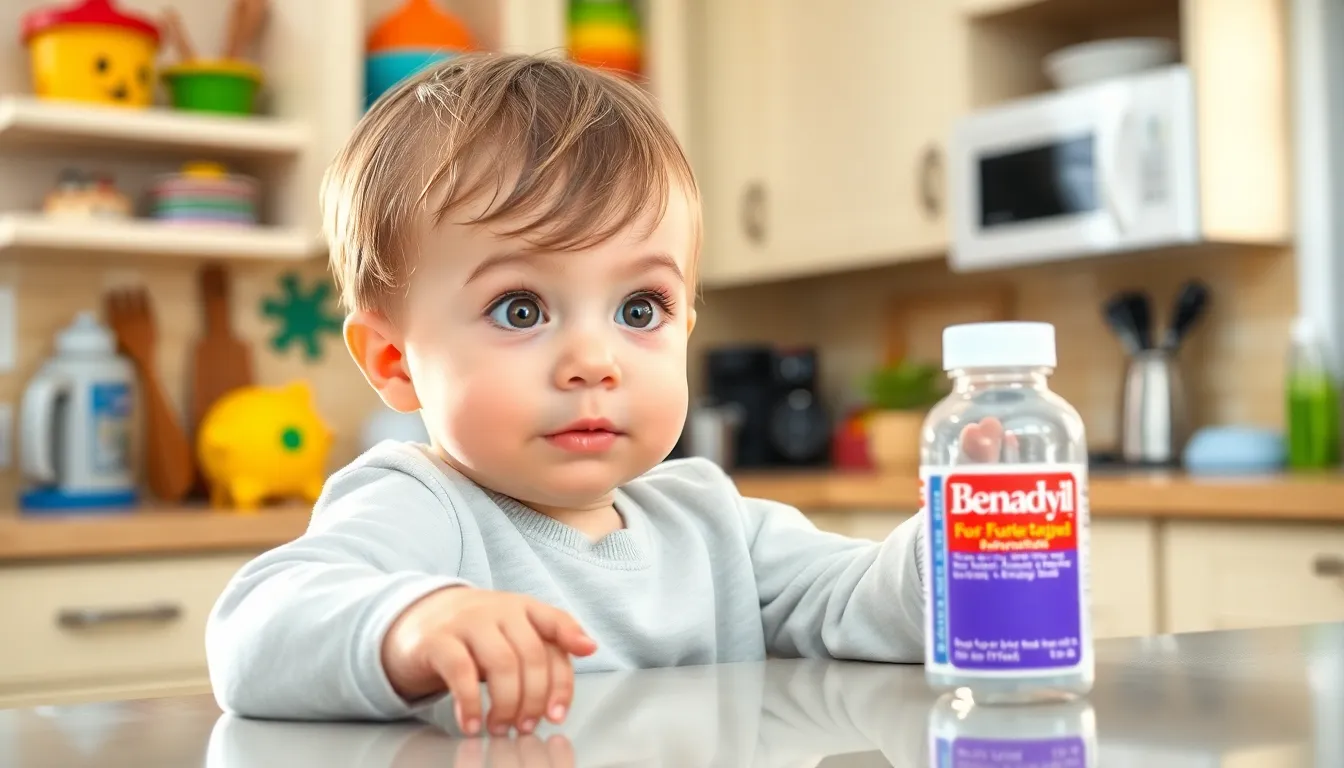When it comes to parenting, sleepless nights and restless toddlers can feel like a rite of passage. Enter Benadryl, the over-the-counter hero that some parents swear by for allergy relief or a little extra snooze time. But before diving into the world of pink liquid magic, it’s crucial to know what you’re really getting into.
Table of Contents
ToggleOverview of Benadryl
Benadryl contains diphenhydramine, an antihistamine that relieves allergy symptoms. Parents often use it for conditions like runny noses, sneezing, or itching due to allergies. Some individuals administer Benadryl to help settle toddlers during sleepless nights, seeking its sedative effects.
Dosage guidelines vary for children, with recommendations based on age and weight. Benadryl’s packaging provides clear dosing information. Generally, for a two-year-old, the dose is typically one teaspoon. Consultation with a pediatrician maintains safety when considering this medication for young children.
Side effects may include drowsiness and dizziness. Parents should watch for potential reactions, such as excessive sedation, irritability, or difficulty breathing. Those symptoms warrant immediate medical attention. It’s important to avoid combining Benadryl with other sedatives unless directed by a healthcare provider.
Long-term use in young children raises concerns regarding development and behavior. Research suggests that routine administration may affect cognitive function, leading to difficulties in learning or attention. Monitoring a child’s response to Benadryl during administration ensures safety.
While Benadryl can be effective for allergy relief, its use in toddlers requires caution. Parents must weigh potential benefits against risks. Understanding these factors contributes to informed decision-making regarding their child’s health and wellbeing.
Dosage Recommendations

Dosage for Benadryl in children, particularly for a two-year-old, relies on age and weight. Careful adherence to recommended dosages ensures safety and effectiveness.
Safe Dosage Guidelines
For children aged two, the typical dose of Benadryl (diphenhydramine) is one teaspoon, equivalent to 5 milliliters. This dosage can be given every four to six hours as needed, but it’s essential to limit use to no more than four doses in a 24-hour period. Evaluating the specific product’s instructions is crucial, as concentrations may differ among brands. Consulting a pediatrician becomes vital for personalized advice and to address specific health conditions or concerns.
Age-Specific Considerations
Age significantly influences how medications affect children. Different age groups experience varied sensitivities to medications. While Benadryl may help alleviate allergy symptoms in toddlers, young children can be more susceptible to adverse effects, including excessive sedation or irritability. Monitoring their reactions post-administration is a responsible approach. Professional guidance through a pediatrician is advisable when parents consider Benadryl for a child under six years old, ensuring safety and appropriate use.
Uses of Benadryl in Young Children
Benadryl serves specific purposes in young children. Parents often turn to it for allergy relief or as a sleep aid during restless nights.
Allergy Relief
Benadryl effectively alleviates allergy symptoms. It targets issues like runny noses, sneezing, and itching. Relief typically occurs within an hour of administration. Parents administering this medication should observe their child’s weight to determine the correct dosage. A common recommendation for a two-year-old is one teaspoon (5 milliliters) every four to six hours. However, the total shouldn’t exceed four doses in a 24-hour period. Consulting a pediatrician ensures the safe use of Benadryl, especially since individual reactions may vary. Awareness of potential side effects remains essential during allergy season. Monitoring for unusual reactions guarantees a safer experience when using the antihistamine for young children.
Sleep Aid
Benadryl’s sedative properties encourage sleep in some toddlers. It can help settle restless children experiencing sleepless nights. However, reliance on Benadryl as a sleep aid raises concerns. Short-term use presents fewer risks, but long-term use may impact cognitive function. Pediatrician input is vital before deciding on dosing for sleep purposes. A single dose may suffice for occasional use, but parents must avoid frequent administration to prevent dependency. Regular evaluations of a child’s sleep patterns might reveal alternative, safer solutions. Careful monitoring during use allows parents to address any adverse effects promptly. By prioritizing their child’s health, parents make informed decisions about employing Benadryl for sleep assistance.
Potential Side Effects
While Benadryl offers some benefits, it comes with potential side effects. Parents should remain vigilant when administering this medication to their two-year-olds.
Common Side Effects
Drowsiness often occurs as Benadryl acts as a sedative. Other common effects include dryness in the mouth and slight dizziness, which may affect some toddlers. Parents might notice irritability in their child after taking the medication. If any of these symptoms escalate or persist, consulting a pediatrician becomes necessary. Monitoring for changes in behavior or mood can provide valuable insight into how the child reacts to the medication.
Serious Risks
Serious risks associated with Benadryl usage include respiratory depression or difficulty breathing. These situations demand immediate medical attention. Additionally, excessive sedation can occur, causing extreme lethargy in the child, which requires careful observation. Long-term use raises concerns about cognitive development, as studies indicate potential learning and attention difficulties in young children. Therefore, professional guidance is crucial when considering this medication for toddlers to avoid harmful effects.
Alternatives to Benadryl
Parents often seek alternatives to Benadryl for their two-year-olds, especially when considering allergy relief or sleep aids. Several options exist that can help manage allergies without using diphenhydramine. Antihistamines like loratadine and cetirizine are safer choices for young children, as they typically cause less sedation. Commonly available in liquid form, these medications are easier for parents to administer.
For sleep issues, non-medical strategies can also be effective. Establishing a consistent bedtime routine benefits toddlers, signaling that it’s time to relax. Activities such as reading a book or taking a warm bath may help soothe a child before sleep. Furthermore, avoiding sugar-laden snacks before bed helps minimize hyperactivity.
Humidifiers can also aid children suffering from allergies or congestion. Moist air reduces nasal irritation and promotes easier breathing. Many parents find that using saline nasal drops clears nasal passages, providing additional relief without medication.
Natural remedies, including honey for children over one year, contribute to soothing sore throats and reducing coughing. Herbal teas like chamomile serve as calming beverages, promoting relaxation during evening time.
Consulting a pediatrician remains essential for tailored advice and recommendations. They can guide on the appropriateness of specific alternatives, ensuring safety. Parents often feel reassured when they choose solutions that support their child’s health without the potential risks associated with Benadryl’s long-term use.
Consultation with Pediatrician
Consulting a pediatrician becomes crucial before administering Benadryl to a two-year-old. Professional guidance ensures that the dosage aligns with the child’s specific needs based on weight and overall health. Pediatricians often provide personalized advice, considering alternative medications or therapies that may pose fewer risks.
Engaging in a dialogue with a healthcare provider allows parents to understand both benefits and potential side effects of Benadryl. A pediatrician can evaluate whether the child’s symptoms warrant antihistamine use or suggest safer options like loratadine or cetirizine. Additionally, healthcare professionals can discuss non-medical strategies that may effectively address sleep issues, such as establishing a bedtime routine or using calming techniques.
Monitoring reactions to any medication, especially in young children, is important. Side effects like excessive drowsiness or irritability could indicate that Benadryl isn’t suitable for the child. Parents should always have a clear plan in place detailing when to seek medical help based on their child’s response.
Long-term use of antihistamines raises concerns, particularly regarding cognitive impacts in children. Consulting a pediatrician helps parents navigate these concerns while ensuring the child’s health remains the priority. Ultimately, the child’s safety and well-being hinge on informed decisions guided by professional advice. Engaging with a pediatrician not only empowers parents but also fosters a safe environment for raising healthy toddlers.
Parents must approach the use of Benadryl for their two-year-olds with caution and informed decision-making. While it can provide relief from allergies and occasional sleep disturbances, understanding the potential risks is essential. Consulting a pediatrician ensures that any medication aligns with the child’s specific health needs and avoids complications.
Monitoring for side effects is crucial, as young children can react differently to medications. Exploring alternative solutions for sleep issues and allergy relief may also be beneficial. Ultimately, prioritizing a child’s safety and well-being is the best approach to navigating parenting challenges.



